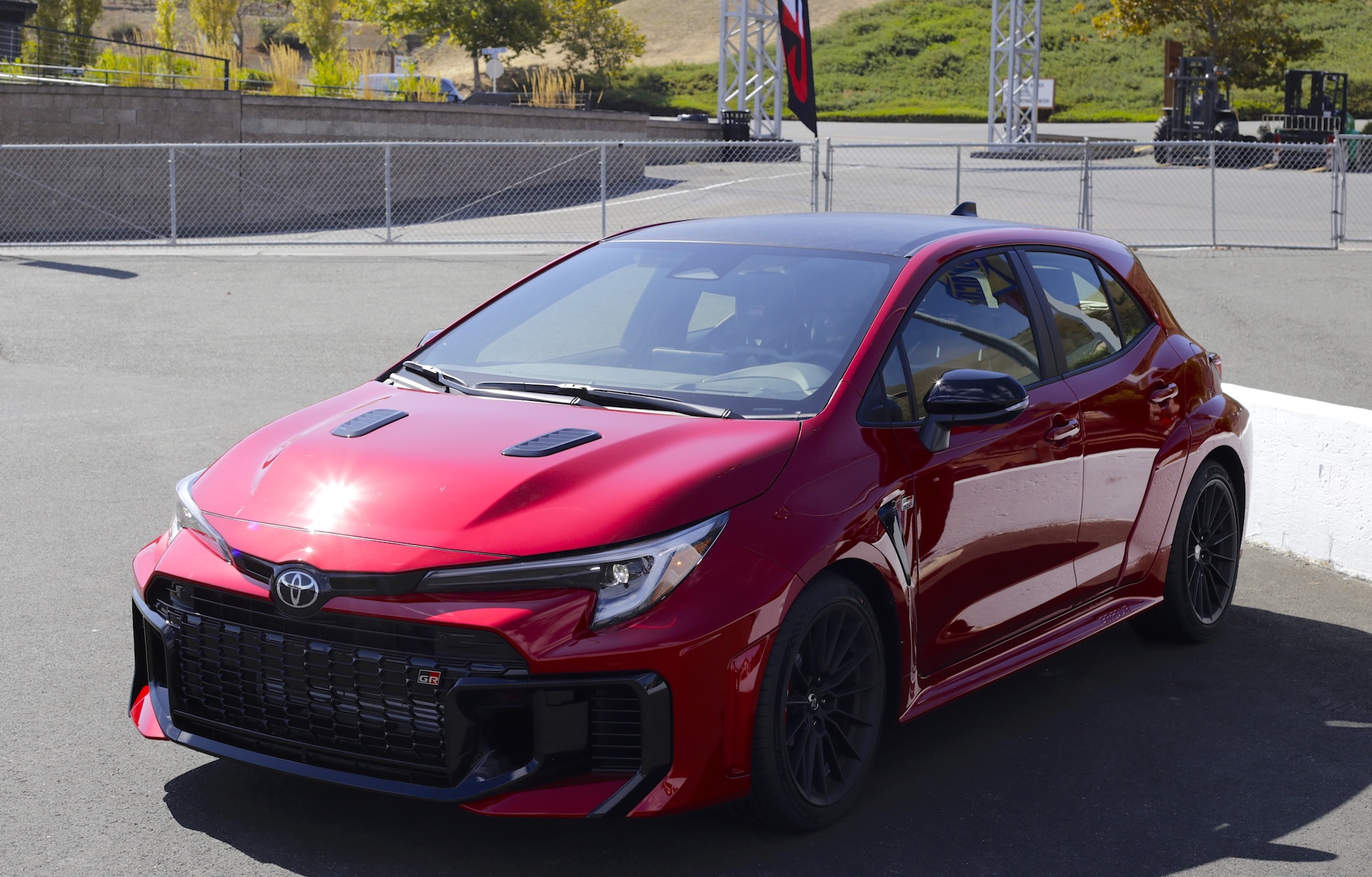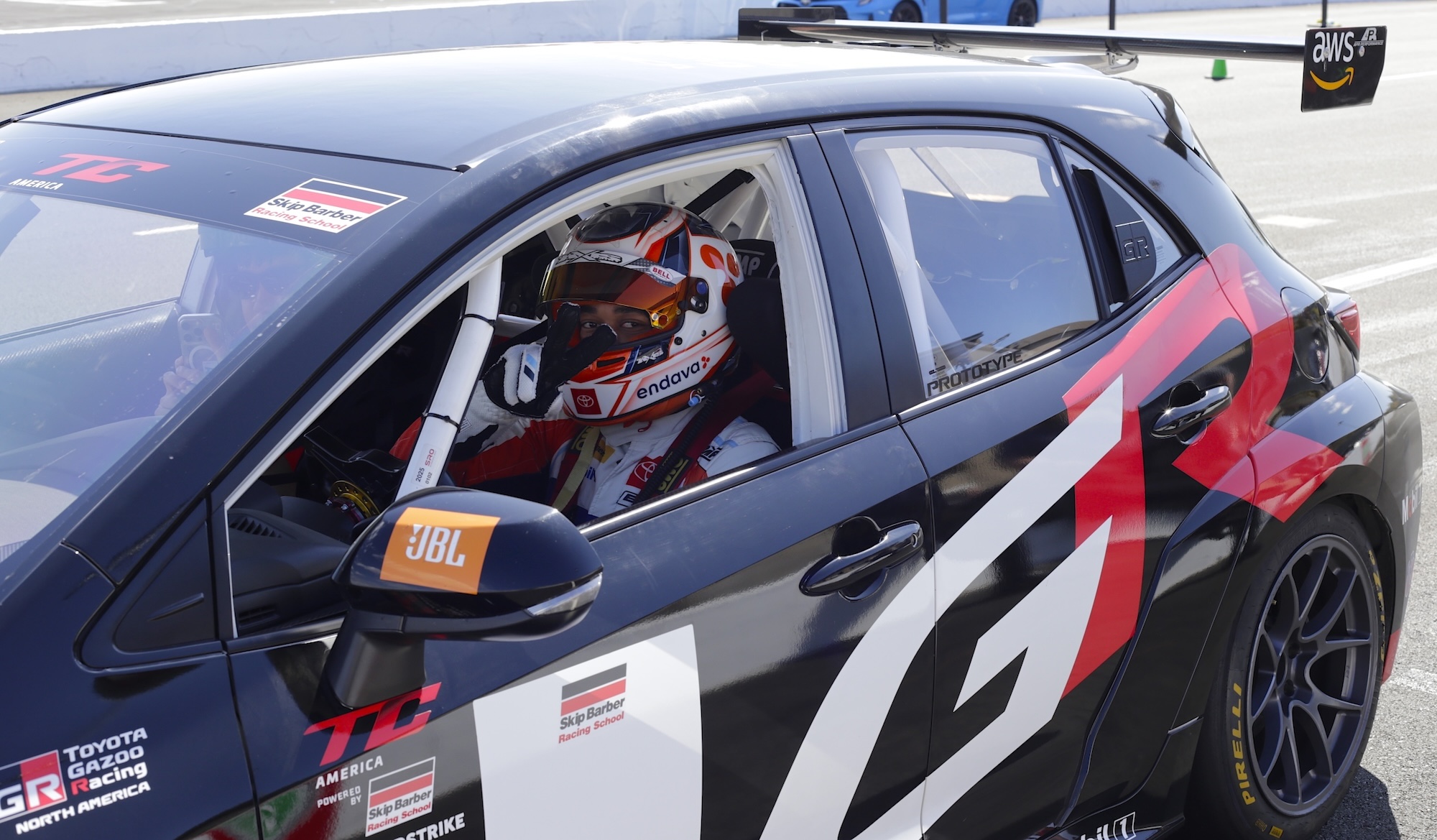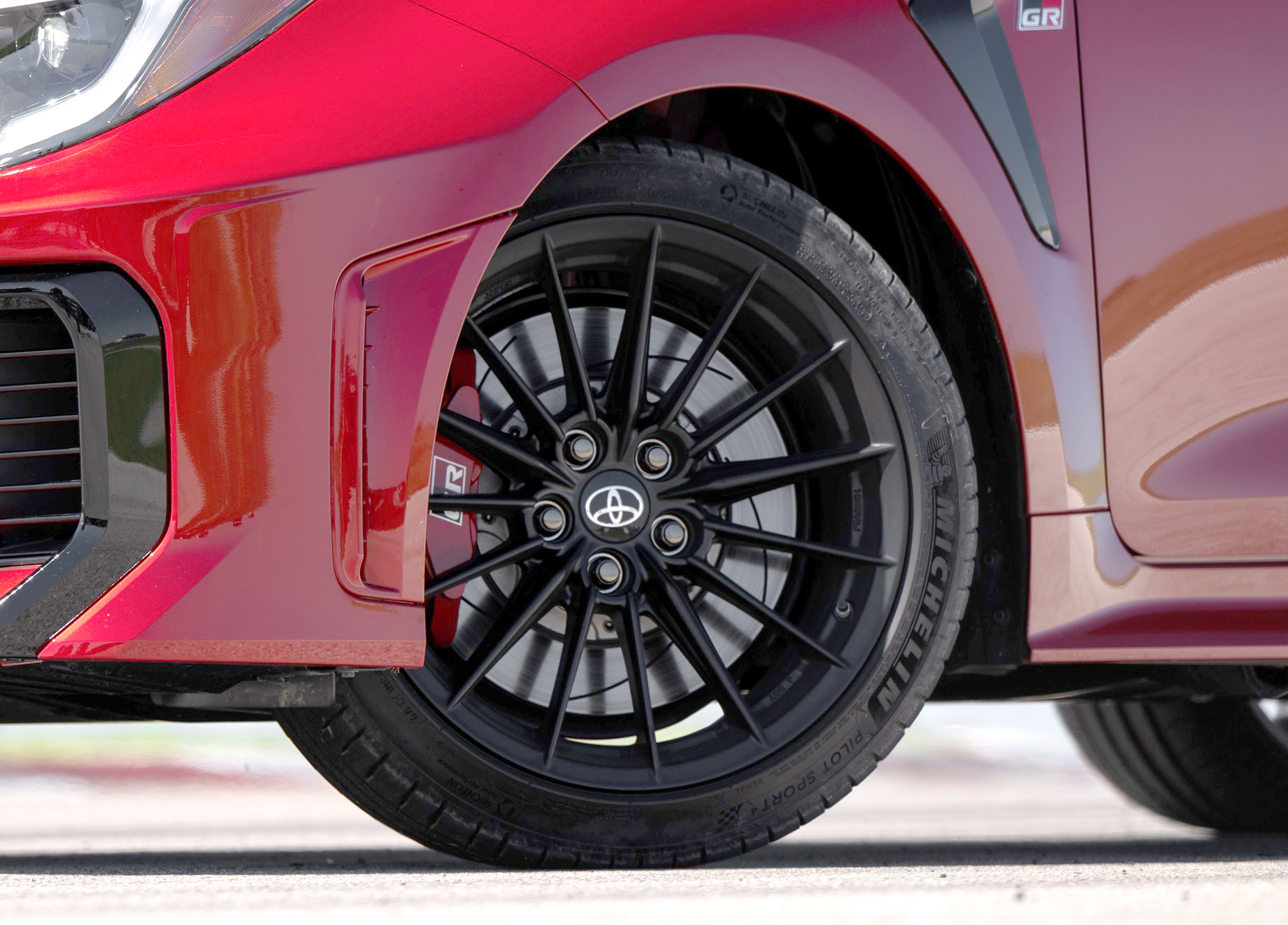As car generations tick off the years, automakers typically either institute minor changes—such as colors, interior materials, and tech offerings—every year, or wait until a couple have passed before throwing out a significant refresh. But for a manufacturer to make a bunch of small yet significant tweaks every single year of its short run? Generally unheard of. Well, besides Toyota and its all-wheel drive GR Corolla hot hatch.
Kicking off at $41,119 (the higher-tier Premium Plus trim starts a couple of grand higher), the 2026 Toyota GR Corolla is better, sharper, and louder than ever. Despite not much changing exterior-wise, it’s been a work-in-progress that will tickle the fancies, pique the interests, and conjure up the awooga! eyes of enthusiasts across the board, especially those who consider themselves steering and handling connoisseurs. Let’s discuss what Toyota’s tweaked since the GRC’s debut in 2023—especially for the 2026 model year—that’s gotten it to this point, and made it into a true Hot Hatch Great.
Full disclosure: Toyota housed and fed me for a little over 36 hours in Napa County, California, so that I could attend its event at Sonoma Raceway. It threw myself and a gaggle of journalists the keys to, among other models, several iterations of GR Corolla for ripping laps on this mega-fun and quite beautiful NorCal circuit.

Fast Specs
Here’s a quick refresher on what kind of animal the GR Corolla currently is: Its all-aluminum G16E-GTS 1.6-liter three-cylinder turbo puts out 300 horsepower at 6,500 RPM and 295 pound-feet of torque at 3,250-4,600 RPM. Boost pressure maxes out at 26.3 PSI, curb weight comes in at 3,296 pounds for the base manual variant (adding some more creature comforts tacks on just a couple of extra pounds), and it’ll cross the 60 mph mark from a stop in just 4.9 seconds.

I remember the ‘23 model year’s unveiling like it was yesterday: Toyota officially did so by having two GR Corollas rip donuts inside of a nondescript warehouse in Long Beach. It certainly set the tone—this mighty hatch was destined to be a good time. And it was! Initial impressions were quite positive—including from The Autopian’s own Thomas Hundal.
Despite being widely regarded as a fast and well-handling all-wheel drive hot hatch, Toyota’s never stopped tweaking it in one way or another over its now four-year run. To make the most of its power- and drivetrain, it’s made some pretty nerd-spec alterations. Let’s dig into what exactly they are.
A Several-Year Progression
For the follow-up 2024 model year, Toyota truly got down to brass tacks by improving electrical conductivity. By optimizing where the battery’s grounding connection in the body—meaning having more un-painted metal for it to, well, ground to, Toyota says this improved steering responsiveness by allowing the system to work more efficiently. But if you think that’s the finest of tuning, get a load of this: Toyota also redesigned front bumper vents so that air flows through them more efficiently, and slapped on aluminum tape that cuts down static electricity interference.
The latter may be a bit of every-little-bit-counts stretch for some, but it’s at least more believable than replacing modern medicine with crystals.
2025’s updates were far more noticeable. Such as a one-ish PSI increase in boost pressure, which increased torque up to 295 pound-feet from 273. Additionally, Toyota revised ABS tuning and did some substantial suspension tweaks, like adding rebound springs to the shock absorbers for a more controlled ride, stiffening the rear springs and decreasing the sway bars’ diameters for more body control under acceleration, cornering, and braking, and increasing the rear trailing arm’s height. But the most minuscule yet respectable alteration took the form of its hardware: thicker and more rigid bolts were fitted in key areas.
To promote a more connected-to-the-road feeling, the steering column mounting bolts’ washers were increased from 20mm to 22mm in diameter, with grooves added to soak up vibration and twist, while the bolt heads themselves increased from 14mm to 17mm. The bolts that fasten the front lower control arms to their knuckles gained ribbed flanges for more rigidity, and those that mount the shock absorbers to the body gained a 1mm-thicker flange. Talk about a different kind of nut-and-bolt restoration.
Finally, Toyota introduced a torque-converter’d eight-speed automatic transmission option for the 2025 model year. Quick note before some track impressions: It works well enough, but get the stick if you’re able to.
Finally, 2026’s updates: 45.6 more feet of structural adhesive for joining the various bits of unibody together more tightly, and a second air intake duct to send more cool air to the filter element. Oh, and we can’t forget about the addition of Active Sound Control (ASC), or, more commonly known as fake engine noise.
What Does Each Change Feel Like?
To feel these tweaks for myself, Toyota lined up a 2023, 2025, and 2026 GRC at Sonoma Raceway and had me experience the evolution firsthand.

First up was the OG ‘23. Having recently driven a 2026 Volkswagen GTI, I was especially in-tune with hot hatch handling tendencies—the ‘23 GRC was no disappointment. While its steering and turn-in felt muted on this track’s rollercoaster-like flow, body roll was respectably contained, and its torquey turbo-three felt great. The shifter had a good, positive feel, though heel-toe was a little tough to master due to slightly awkward pedal positioning. The real treat was the all-wheel drive system’s confidence: I loved mashing the throttle as early as possible at corner exit, and was impressed by its grip through the track’s high-speed chicanery towards the end of each lap (Toyota set up an abridged version that cut out the circuit’s famous Turn 11 hairpin and required we pit-in every lap). Despite its Michelin Pilot Sport 5 tires not being the most ideal track compound.
A fine start, but next was a ‘25 GRC sporting two revisions-worth of suspension, cooling, and chassis upgrades, plus a bit more oomph.
I could instantly feel the difference at the helm of the one-year-newer model. Steering felt far less vague and instead had excellent response and weight; it felt more confident and eager to turn-in this go-’round. Body roll was also reduced, which bolstered grip and control through the aforementioned chicanes.
Job well done, but then I hopped in the latest 2026 iteration. The most apparent difference in this fresher steed was the addition of fake sound, which clued me in on exactly where the revs were at. It was a generally good fake sound, too—it did the rowdy off-beat three-cylinder rumble justice. Synthetically louder still counts as louder.
Otherwise, the front-end felt even more confident during turn-in, and I even put it to the test by braking and correcting mid-corner through one of the fast chicanes. This often causes non-sports cars to flounder a bit, but the GRC held firmly. The difference in front-end feel and confidence under cornering made me ponder Toyota pulling a fast one by disconnecting the front sway bar on the ‘23 example. Unfortunately, it would’ve been a bit awkward if I broke out a trolley jack and started buzzing off lugnuts with an impact wrench (hey, I don’t make the rules). Kidding, but the handling improvement really was apparent.
Non-Handling Observations
As far as noticing a difference with more cool air fed into the GRC’s airbox go, unfortunately conditions didn’t permit this. It’s possible that repeated, consistent hot laps with a lap timer could’ve, though, as its main function is to keep intake air temperatures down during the increased under-hood heat of track work. In fact, Toyota reps said that they had the Nurburgring in mind when they made this change, since it’s a very long circuit. Prolonged heat from the oil cooler, radiator, and engine overwhelm intake ducting after a while, significantly increasing the air’s temperature before it gets sucked through the turbocharger and then sent through the intercooler on its way to the intake valves. The cooler the charge starts out, the denser it’ll be when it mixes with fuel and spark, making more—or at least consistent—power.

One particular characteristic shared by both the ‘24 and ‘26 GRC was being under-tired. By this, I mean that their Michelin Pilot Sport 5s felt awfully pillowy under hard and/or fast cornering, and couldn’t cash the checks that these GRCs’ chassis were writing. This matched my experience with other 300-or-so treadwear tires on track: their sidewalls are awfully soft, they’re very sensitive to temperature, and start to scrub grip far sooner than stiffer, more focused 200-treadwear fare – even when the brakes felt up to the task. Word to the wise: If you’re thinking about picking up any iteration of GRC and tracking it, consider a second set of wheels with any middle-of-the-road 200-treadwear compound mounted up.
The Hot Hatch We Need
After several hours of turning laps in not only the GRC, but also the latest GR Supra and GR86 sports cars, one particular thing stuck out to me: I’m glad this all-wheel drive hot hatch exists. It’s good fun on track, it makes a good noise (inside and outside), and doesn’t pull any punches in expressing exactly what it is.

While focused on performance, the 2026 Toyota GR Corolla still makes a great everyday commuter, too. I drove one from the hotel to the track during the morning Bay Area commute and can attest to its easy clutch, roomy interior, comfortable sport seats, good ride quality, and entertaining power- and drivetrain. It does what every Good Hot Hatch ought to: with loads of low-end torque and plenty of entertaining turbo noises to hear with the driver’s window down, it livens up even the most bland A-to-B moments.
Considering the amount of tweaking that’s gone into it over the years, plus having the ability to switch between a 60:40, 50:50, and 30:70 power split between its Torsen limited-slip differentials, the GR Corolla guarantees confident fun in any scenario. Even at the hands of a pro: I had the chance to ride right-seat with pro-drifter Ryan Tuerck at the wheel. It was downright pupil-dilating what a skilled helmsman with access to a mechanical handbrake could do with a bone-stock example on those same Pilot Sport 5 tires.
Everything Toyota’s done to the GR Corolla makes it one of the most fun new driver’s cars I’ve had the chance to wheel this year. Plus, who doesn’t dig it when engineers readjust their pocket protectors, push their glasses back up to where they’re intended to sit, and find clever ways to make cars handle better? And with there sadly not being much else like the GR Corolla on sale at the moment, I hope this loveable hatch sticks around for a good, long while.
Top graphic image: author









I’ve had my ’23 GRC since July of last year & still look forward to driving it every day. If we had the Yaris (smaller car with same stuffs) I’d rather have that, but otherwise I am very happy.
I get the thinly-veiled ad that this article is supposed to be, since basically Toyota paid for it, but in the real world they’re the car company that denies warranty to people who took their new GR Yaris to a track day and it blew up, even though they advertise it as a track-capable car and sometimes have track day giveaways with the car purchase.
https://www.motor1.com/news/729265/toyota-gr-corolla-warranty-claims-weird-reasons/
Also it’s not just the Yaris, GR86 owners have been dealing with warranty denials for many years.
Are their any manufacturers that honour warrantees for damage done on a track?
Yep, as long as you haven’t modified it (hardware or software, aka flashing a tune on the ECU), otherwise they could also exclude towing, or driving short distances, or other type of driving conditions.
Cool story bro
Great article!
I love the detailed dive into what Toyota did to change the dynamics of toe cat,
“To promote a more connected-to-the-road feeling, the steering column mounting bolts’ washers were increased from 20mm to 22mm in diameter, with grooves added to soak up vibration and twist, while the bolt heads themselves increased from 14mm to 17mm “
Are the engineers trying to lower the frequency of the vibrations transferred through the steering with those changes while generally raising the stiffness and resonant frequency of the car.
It is interesting to read about literally tuning the car as a resonant filter —everything in the world can be described as a resonant filter, but I digress.
If I were in the new-car market I’d definitely be looking at this. As the car ages, I wonder how some of the measures taken to tune the car will age.
For example, the adhesive used to bond the chassis. More of it increases stiffness, at least at low frequencies, maybe dampening some high frequency buzz and harshness. Is the adhesive acting like a glassy polymer or like a non newtonian fluid? How does the adhesive age?
So much to think about before coffee.
And stupid Ford and Gm won’t sell us Focus ST, Fusion ST, because America first!
Only Honda, Toyota, Subaru and VW only care to sell cars to Americans
You’re in Napa for a vertical… testing?
The price is getting too close to that of the Golf R to not mention it’s existence.
They don’t seem like competitors to me. Golf R is larger, auto only and more of a quiet nice car for daily driving. GRC is loud, low rent inside rowdier thing. The buyers of one would be disappointed in the other.
They aren’t even close in price. Base golf R is 49,455, base GR is 41,119. That’s almost 20% and good luck finding a base golf R at a dealer.
Good article, definitely makes me want to figure away to financially justify getting on of these, as they really seem to hit all the right points and I do not want to be buying one of these used in a few years. These are in that group of enthusiast cars that ends up with about a 95% beat to hell rate within a few years. That thought feeds my soul in so far as these are being driven like they were intended, but I will not want one second hand. I lived the life of the DSM for too long.
Of course I’ve been impressed by the GR Corolla since it came out. To my mind however, I think the GR Yaris (which we don’t get in the states of course) is more appealing, but that’s just me.
I’d just be happy if they let the regular Toyota hatch get the hybrid drivetrain, or better yet, just let Americans buy the Corolla wagon with the hybrid drivetrain, or the regular gas ICE with a manual shifter, which of course, they won’t.
GR Yaris?
It’s not just you.
I know. 🙂 My tendency towards hyperbole. 🙂
Even the non-GR versions of the Yaris for the markets other than the U.S are pretty appealing, and likely sporty enough for most anyone’s daily use: https://www.motorpoint.co.uk/guides/toyota-yaris-models-and-trim-levels-explained …I think they undercut the Honda Fit/Jazz in price a bit too.
I know such cars aren’t popular among U.S. buyers so we don’t get them here, but a practical, Japanese-made slightly sporty hatchback with a hybrid engine (or even just a small torquey efficient NA engine) is so appealing to me.
Peter Nelson! Love your track reviews!
Aw thanks!
Yep loved all your Mazda2 and 1-Series write ups and lots of other stuff!
OK, so maybe I’m out of the loop, but that is just crazy that you can turn an knob and set the front/rear power split like that.
The WRX STi had that for a few years in the US, too.
A bit more than “out of the loop” seeing as Subaru introduced DCCD, Driver Controlled Center Differential, in Japan 31 years ago and the US 21 years ago…
Our Subaru is older than that, and my knowledge of such matters starts and ends at “Borg-Warner transfer case.”
Then you’ll be excited to learn the modern active BorgWarner transfer cases can shuffle torque F:R or opposite constantly as needed!
Toyota gets a lot of crap sometimes for their offerings. Not from me though.
If I could afford a new one of the Corollas this would be it…
This car is pretty much at the top of the list if I had to replace my beloved Evo (and had the coin). I really like the Civic Type R as well, but the AWD and general hooligan-ness of the GR has me smitten.
This car is begging for some fun exterior colors. That baby blue and Toyota’s usual sonic red are the only interesting ones. How about a bright yellow, or forest green, or orange? Anything other than black white silver grey please.
If they made it in a nice orange, yellow, green, or purple, I’d already have one. Even that bluish-greenish Everest color on the 4Runner would work. Hell, even the “Taliban Tan” on the Tacoma would be amusing. I’d even take the “pearl primer gray” color over the usual metallic dark gray.
As it stands, if I get one, I’d probably get the “wish we could use Mazda Soul Red” Sonic Red, or the dark gray with an asymmetric over the top stripe in my and my wife’s favorite color combination, Dunkin’ Donuts pink and orange.
It’s very surprising that Toyota hasn’t offered the “GR-Line” as a trim to the base Corolla hatch as they have elsewhere in the world.
The hood vents look like they came from Pep Boys. ND.
But unlike Pep boys they are actually venting.
And this site is a pop-up blockers dream. Autoplay videos again. Why?
If you subscribe they’ll turn ’em off.
Clearly, this person hasn’t been on the drive website
They do not. I paid for membership and all of them scammed me by “forgetting” some stuff I paid for and half assing the rest. Normal day for shyster Tracy